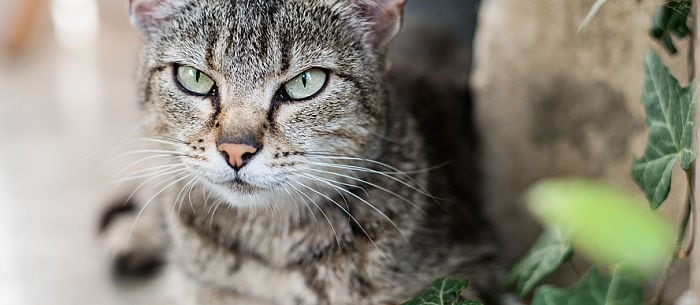Most cats love to roam the yard and garden. Some even like to chew on your plants. But what if you don’t want your beautiful landscape dug up or used as dinner for the local felines? Finding (or making) a natural cat repellent may be your answer.
Natural repellent comes in two forms: a plant which cats cannot stand the smell or taste of, or a topical substance that is sprayed or rubbed onto the plants and surrounding soil. With some basic knowledge of which substances safely repel cats, you can keep the kitties at bay and your garden looking great.
What Is a Repellent?
A repellent is a substance that’s considered distasteful or offensive. Cats are repelled by certain smells and substances, so when used in the garden, these deter them from wanting to be there or to chew on the plants. Of course, the first line of defense should be fencing your garden off from feline visitors, but sometimes they find their way in and you’ll need another plan!
First, consider using plants that cats can’t stand due to the taste, smell or both. The Coleus canina, as shown in HGTV Gardens and also known as the “scaredy cat plant,” is one that cats actively avoid due to the odor. It is a very pretty plant, so it looks great in any garden. Humans cannot smell the plant unless they touch it, so wear gloves when planting or pruning. Another tactic is to plant rue and chives, herbs that also work to deter cats.
Topical Repellents
Another method for keeping cats away from your plants is to use a natural cat repellent on the plants themselves. The American Society for the Prevention of Cruelty to Animals (ASPCA) suggests a few commercial products, such as Grannick’s Bitter Apple, but you can also make a natural cat repellent at home with some simple kitchen ingredients.
According to the ASPCA, cats typically dislike the smell of citrus, so using orange, lemon or lime peels sprinkled around plants can help keep cats away. Using the oils of these citrus fruits is also a smart solution, since they are nontoxic to humans and cats.
Some gardeners have found success with rubbing raw onions on plant leaves and spraying white vinegar around plants. This can be a process of trial and error. You’ll need to determine what works to repel the particular cat who’s munching on your plants. Like humans, cats have preferences as well as distaste for certain smells and tastes that bother them. If one of these natural repellents doesn’t work, try another one.
Cat Repellent Recipe
Here’s a very simple homemade recipe from LoveToKnow for a natural cat repellent with cinnamon, rosemary, lavender, vinegar and tangerine essential oil combined with water. You’ll just need those items, a piece of cheesecloth and a spray bottle.
Repellents To Avoid
- Never use mothballs in the garden. They are toxic to cats, humans and even the soil.
- Hemlock is a natural repellent, and it’s commonly used as mulch. But it’s poisonous to cats, so don’t use it as mulch or a deterrent.
- Most household cleansers have toxins harmful to cats, so don’t use those either. Make sure your pet caretaker knows what items are dangerous so they can avoid any unnecessary trips to the vet.
- Cayenne or chili pepper (both ground and in flake form) is often cited as a deterrent, but it has the potential for making a cat sick.
Interested in learning about other natural alternatives for your pooch? Check out how to make Homemade Dog Shampoo.
Laura Richards is a Boston-based freelance writer and the mother of four boys, including a set of identical twins. She is also mom to three rescue pets: Scarlett, a 7-year-old beagle, and Edith and Ollie, 15-year-old identical twin black cats. She has written for numerous parenting publications and is the president of On Point Communications.





